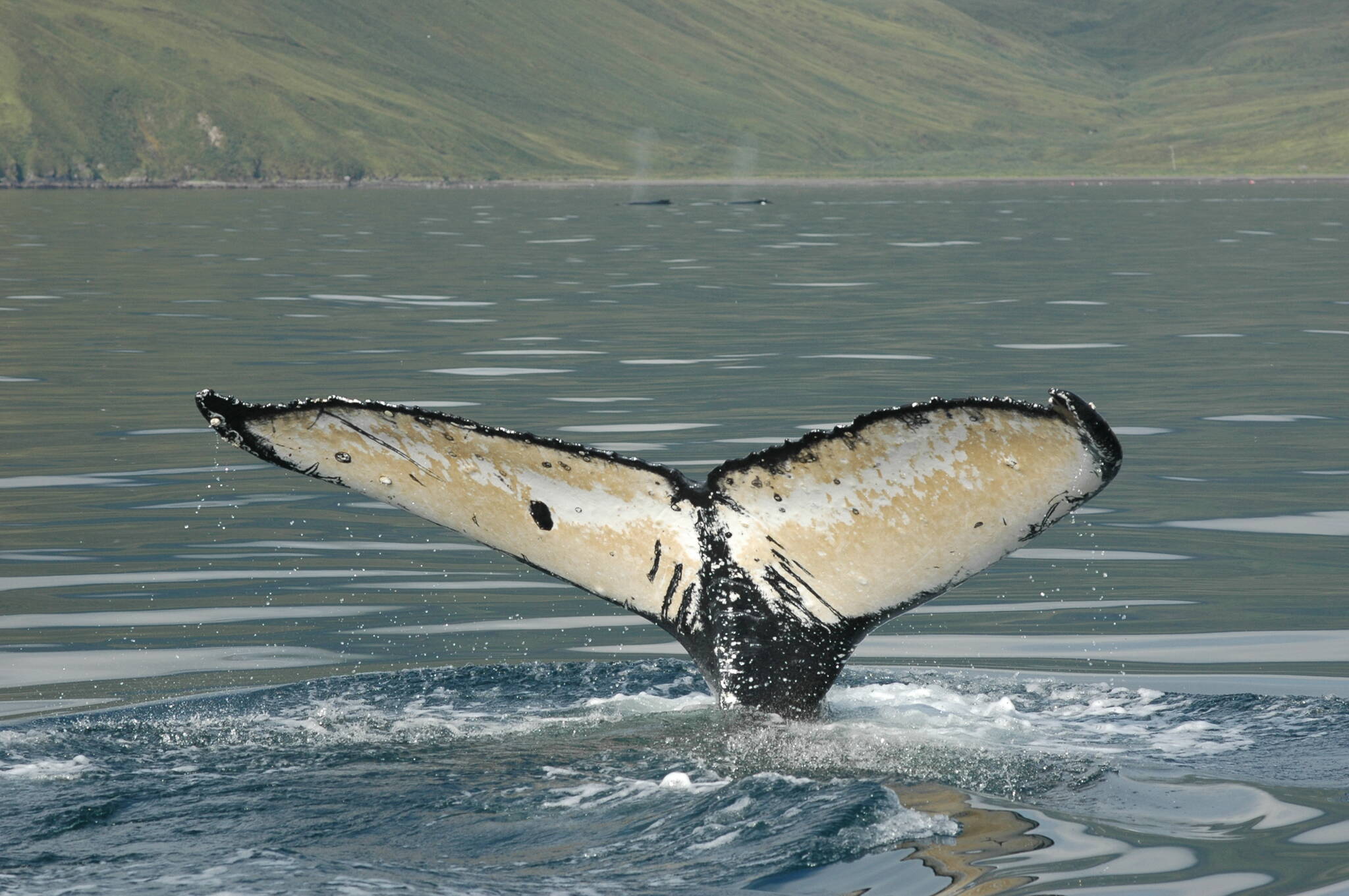If you’ve taken the ferry to Point Defiance lately, you may well have been treated to the sight of one or more humpback whales hanging out in Dalco Passage.
Although we don’t see large numbers of them, they’re the most common great whale to inhabit our island waters. They also show up periodically off downtown Seattle.
The humpback is large, growing to around 55 feet, with a maximum weight of 40 tons. The scientific name, Megaptera novaeangliae, means “big wing of New England”, a reference to the huge flippers which are one-third the length of the animal (New England was the location of the first scientifically described specimen).
Humpbacks give birth to a single calf over every one to three years, and they can probably live for 70 years or more (I personally know one in New England who is currently at least 54!) They’re known for their breaching and other spectacular aerial behavior, for their curiosity, for the haunting songs sung by males, and for the inventive ways in which they catch fish using “nets”or clouds made of bubbles.
Humpbacks are found in all oceans, from tropical to polar waters. They make a predictable annual migration, dividing their year into two distinct parts: during spring, summer and fall they feed in the productive waters of higher latitudes, with a diet of krill or small schooling fish.
Then, in the winter, they migrate to tropical waters where they mate and give birth. While there, they usually don’t eat for several weeks or even months, subsisting instead on large reserves of fat accumulated in their blubber during the summer feeding season.
Throughout the year, but especially in winter, male humpbacks sing long, complex songs that change over time; somehow all the whales in a particular population keep up with those changes. Songs serve to attract females, and probably also to mediate interactions with other males. When not singing, males compete — often fiercely — for access to females; they’re not always “gentle giants.”
Some humpback migrations are among the longest of any mammal. For example, individually identified humpbacks feeding off the Antarctic Peninsula have been seen again more than 5,000 miles away off the coast of Nicaragua, north of the equator. Others have even been known to switch oceans.
Surprisingly, we still don’t understand why whales migrate. It’s likely a combination of several reasons, principally the advantage of giving birth in warm tropical waters, where calves can put more energy into growth and less into keeping warm.
Another reason may be predator avoidance: orcas are known to kill young humpback calves, and the density of these top predators is much lower in tropical waters than on the whales’ feeding grounds.
Whatever the reason, humpbacks undertake these long migrations across oceans every year, probably using a combination of celestial and geomagnetic navigation to unerringly find their way back to precise locations at both ends of their journeys.
They’re remarkably faithful to particular areas, a trait which is determined matrilineally. Put simply, if your mom was a Washington whale, you probably will be too.
So where do our Washington humpbacks go for the winter? We actually know a great deal about their movements because each whale has a unique black and white pattern on the underside of its tail; it’s like a giant fingerprint, distinguishing that animal from all others. Researchers routinely share photos of individual whales, which are often seen many times over sometimes widely separated areas.
From these collaborations, we know that the most of the humpbacks that feed off the Washington coast migrate to Mexico, although a surprising number travel to Hawaii to mate and give birth. They also range widely during summer: whales from here have been seen again as far away as southeast Alaska, in offshore waters of the Gulf of Alaska, and even off the coast of Russia.
Like all the big whales, humpbacks were heavily exploited by the whaling industry for many years. Being a relatively slow animal — unlike the fast fin and blue whales — they were vulnerable to early whalers, who used sailing ships and hand-thrown harpoons.
But the advent of industrial whaling, with its fast catcher boats, explosive harpoons and huge factory ships escalated the slaughter of the great whales and devastated their populations. In the 20th century, a quarter-million humpbacks were killed, and most populations of the species were reduced by 95-99% of their pre-whaling numbers.
The humpback whales that we see here are part of a population that likely extends from southern British Columbia to northern California, and which was the target of extensive coastal whaling operations across most of its range. In Washington, a whaling station operated at Bay City from 1911 to 1926, when more than 1,900 humpbacks were killed.
While their catching operations ranged from the Queen Charlotte Islands to Oregon, most of the whales were hunted more locally, off or near Cape Flattery. Nor was Bay City the only threat to this population: at various times another 3,500 whales were killed in other feeding areas such as northern California and southern British Columbia, as well as on their primary breeding grounds off Mexico.
As a result, by 1926 the population had crashed. It may well only now be recovering, a century later — but recovering it certainly is. Thankfully, this resilience is a characteristic of humpbacks worldwide: most populations under study are recovering strongly from the excesses of a rapacious whaling industry which almost wiped them out.
Expect to see them off Vashon more and more frequently as they come back.
Phil Clapham is a whale biologist who lives on Maury Island. Prior to retiring in 2019, he directed the Cetacean Assessment and Ecology Program at NOAA’s Alaska Fisheries Science Center in Seattle.


